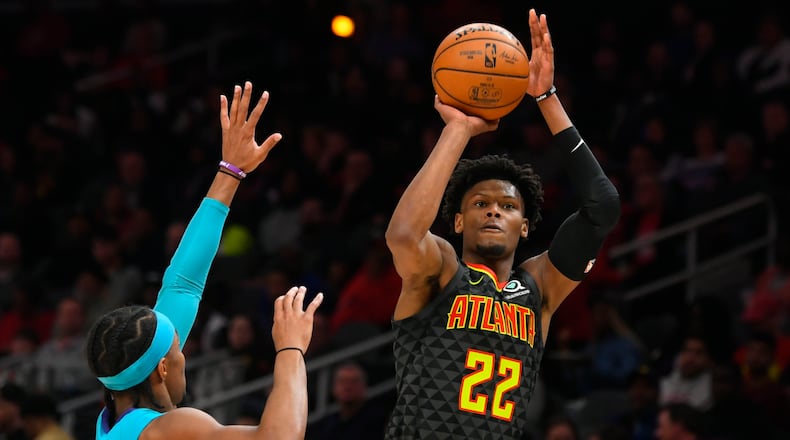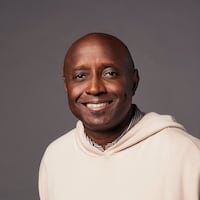The NBA reserved slots in Orlando for teams that were at least decent when the coronavirus pandemic halted play in March. That left out the Hawks, who lost 27 more games than they won. That makes their open talk about the playoffs sound ... well, I guess that depends on your perspective.
Delusional? Presumptuous? Confident? Cocky?
“It’s just a mindset,” Hawks coach Lloyd Pierce said. “We would like to make a huge jump in wins, and we have to have the mindset of what it takes to win. I think we have a very promising young core. I’m excited about adding Clint (Capela) to that mix, and I’m excited about what we are capable of doing in free agency.
“But we have to have the mindset, and we have to get to the point where our guys are ready to make the next step.”
Part of Pierce’s job will be to forge a winning team out of a group that’s mostly known losing. He’ll have better personnel than in his first two seasons as an NBA head coach. The Hawks are set at point guard with All-Star Trae Young, and they have three solid-to-good big men under contract for next season: Capela, John Collins and Dewayne Dedmon.
But the Hawks need dramatic improvement from at least one of their wing players to make a serious bid for the playoffs next season. Four Hawks players logged at least 500 minutes at shooting guard and small forward: Kevin Huerter, Cam Reddish, De’Andre Hunter and DeAndre’ Bembry. None of those players was even average, which didn’t happen with any other Hawks position group.
Huerter, Reddish and Hunter will be back. They are young players with the potential to get better. Playoff teams get at least competent play from their wing players. The Hawks’ wings need significant work to become great at any one thing or good at a few.
I expected more from Huerter in his second NBA season. He’s a good, not great, 3-point shooter: 59 NBA players who played qualifying minutes did better than his 38 percent accuracy. Huerter too often hesitated to shoot when he had space. He was very good at using his size to create open shots near the free-throw line, but just OK at converting them.
I wasn’t a fan of the Hawks surrendering draft pick Nos. 8, 17, and 35 to get Hunter at No. 4. I liked the move a little better once Hunter showed more ability to score off the dribble than I expected. But Hunter was drafted largely on his defensive potential, and he was disappointing at that end even when judged on the rookie curve.
Among the three young Hawks wings, Reddish has the best chance to become a good, all-around player. I thought the Hawks were fortunate he fell to them at the No. 10 pick last year after one lackluster season at Duke. Reddish immediately showed his tremendous defensive potential with good rates for blocks, steals and deflections.
But Reddish struggled at the other end, especially early in the season. His 3-point shooting was awful. That was a problem because Reddish isn’t the kind of explosive leaper who can score over length at the rim. There were lots of awkward, hesitant drives leading to nothing.
Reddish became a better scorer later in the season. He said he had to overcome a mental hurdle after he had surgery for a core muscle injury in May 2019.
“I looked more relaxed, more myself, more comfortable as the season went on,” Reddish said. “Not as timid. Not thinking as much. Letting the game come to me. That’s when I’m at my best.”
Reddish can be a respectable two-way wing player in Year 2 if his offensive improvement carries over into next season. If Huerter plays with more confidence he might take more 3-point shots and convert more of those mid-range chances. Hunter’s perimeter shooting was good, and he has more defensive ability to unlock.
Wing players are important in general in the NBA. They are especially key for the Hawks, who are built around Young. He can be a superstar, but he’s relatively small (6-foot-1, 180 pounds) with no position versatility. Young needs shooters on the wings to create more space for his offensive wizardry and big, strong wing defenders to cover for his shortcomings.
The Hawks have structured their roster and style to complement Young’s game. Collins has extended his shooting range to become a legitimate “stretch” big man. Capela will offer more resistance at the rim. The Hawks will be better if Huerter becomes an elite shooter and Reddish and Hunter take another step toward living up to their billing as high draft picks.
There’s a wide range of potential outcomes for those three players. Hunter, who will be 23 years old in December, is the oldest among them. Young and Collins already are good NBA players and they still have room to grow. Young will be 22 years old in September and Collins turns 23 in the same month.
The Hawks improved this season with better health and roster changes. Next offseason they will have plenty of salary-cap space to fill what general manager Travis Schlenk identified as thin depth at power forward and on the wings. Young has superstar potential and their other key players are still on the ascending part of the aging curve.
Those are reasons why it’s not outlandish for the Hawks to think they can be in the playoffs season.
“I don’t necessarily want to say too much about what I expect next year, but it’s going to be big things, for sure,” Young said.
That’s going to take a huge jump for the Hawks. They have legitimate reasons for optimism, but the reality is they were 11 games out of playoff position when the season stopped. It’s hard to go from awful to the playoffs on one season.
The Hawks will take their shot by leaning on growth from their so-called “core five” of young players, steady play from their veteran big men and better depth. To finally stop rebuilding and start winning, the Hawks will need a lot more from their wing players.
About the Author
The Latest
Featured

